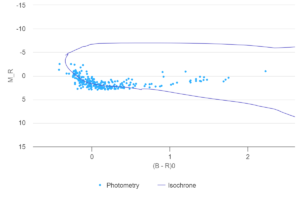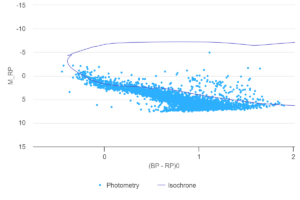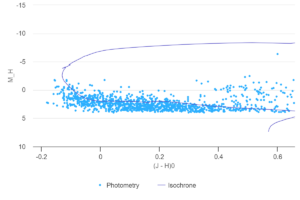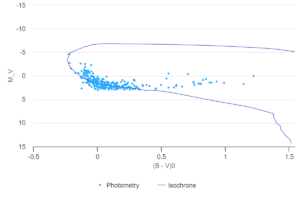NGC 2421 is a young open cluster in the Puppis constellation. NGC 2421 is located close to the celestial equator which makes it somewhat visible from both hemispheres in certain times of the year. This cluster was first studied by Moffat and Cogt in 1975 and presumed to have a distance of approximately 1.87 kpc. Ramsay and Pollacco also studied this cluster using CCD photometry and found that the cluster had a distance of 2.75 kpc. As of April 10, 2024, no other astronomers have studied the cluster NGC 2421 since Ramsay and Pollacco in 1992.
I chose to study the Open Cluster NGC 2421 in my Astronomy 113 class. Using Skynet I was able to capture and observe 15 images of NGC 2421 and analyze the images using Afterglow. Using Afterglow, I was then able to capture the beautiful tri-color image shown above. I then used Skynet’s other website called Astromancer to analyze NGC 2421 more in-depth and find various pieces of information such as the star cluster’s distance, age, metallicity, and reddening of the open star cluster.
The objective of this study was to attempt to learn and understand star clusters on a deeper level using various tools such as Afterglow and Astromancer. The data I found is as follows: Right Ascension: 114.1°, Declination: -20.6°, Galactic Longitude: 236.272°, Galactic Latitude: 0.075°, Cluster radius: 0.128329 (ly), number of cluster stars: 3825, Distance: 2.75 (kpc), Reddening: 0.59 (mag), Log of age: 7.25 log(yrs), Metallicity: 0 (solar), Class: Open Star Cluster, Proper Motion in RA: -3.131 (mas/yr), and Proper Motion in Dec: 3.097 (mas/yr).




Using Skynet’s Astromancer, I was able to create and analyze these four different HR diagrams to help other astronomers obtain a better understanding of NGC 2421. I believe there is still much to know about NGC 2421 and I hope more research can be done on the star cluster in the near future. I learned a lot about star clusters throughout my study of NGC 2421, it would be an understatement to say that this research was one of the most interesting and thought provoking academic studies I have ever done.